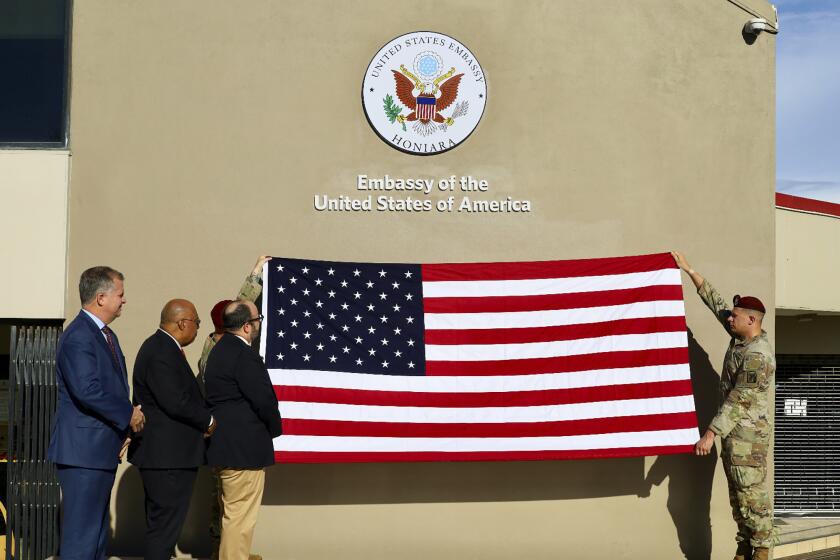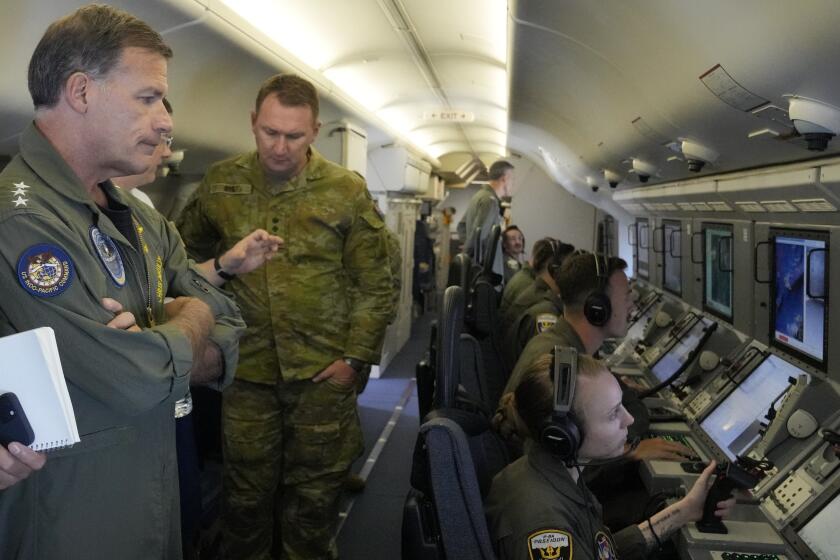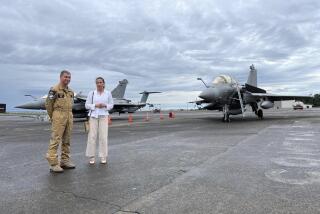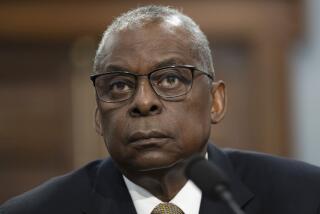U.S. and the Philippines agree on a larger American military presence
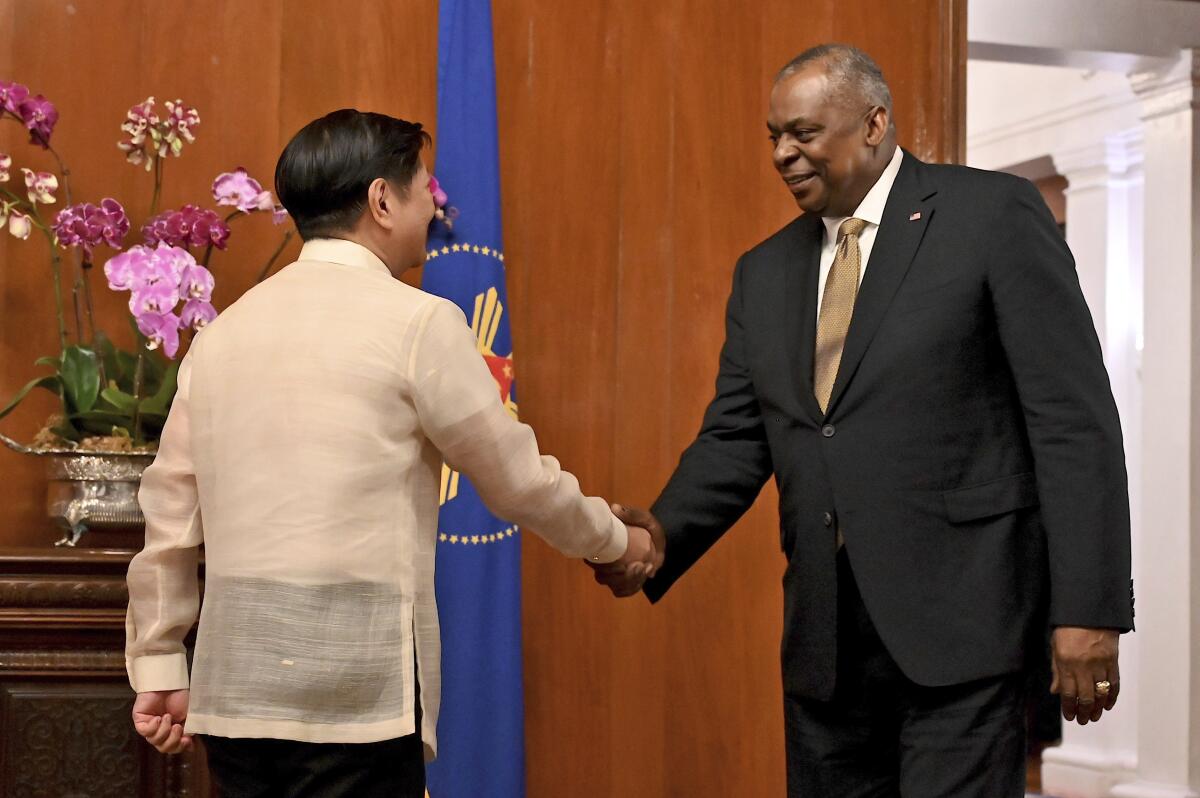
- Share via
MANILA — The U.S. and the Philippines announced an agreement Thursday to expand America’s military presence in the Southeast Asian country, with U.S. forces granted access to four more Philippine military camps as Washington beefs up its efforts to deter China.
The agreement between the longtime treaty allies was made public during the visit of U.S. Secretary of Defense Lloyd J. Austin III, who has led efforts to strengthen America’s security alliances in Asia amid China’s increasing assertiveness toward Taiwan and territorial disputes in the South China Sea.
The allies also said that “substantial” progress has been made in projects at five Philippine military bases, where U.S. military personnel were earlier granted access by Filipino officials. Construction of American facilities in the camps has been underway for years but has been hampered by unspecified local issues.
Austin thanked President Ferdinand Marcos Jr., whom he briefly met in Manila, for allowing the U.S. military to broaden its presence in the Philippines.
“I have always said that it seems to me that the future of the Philippines and, for that matter, the Asia-Pacific will always have to involve the United States simply because those partnerships are so strong,” Marcos told Austin.
American leaders have long sought to reorient U.S. foreign policy to better reflect the rise of China as a significant military and economic competitor.
As the U.S. expands military operations in Australia’s Darwin Port, both countries are uneasy over the fact that a Chinese company controls it.
Thursday’s announcement comes as tensions between China and Taiwan have risen. China claims the self-ruled island as its own territory — to be taken by force if necessary — and Beijing has sent warships, bombers, fighter jets and support aircraft into airspace near Taiwan on a near-daily basis, sparking concerns of a potential blockade or military action.
China and the Philippines, along with Vietnam, Malaysia, Brunei and Taiwan, have been locked in increasingly tense territorial disputes over the busy and resource-rich South China Sea. Washington lays no claims to the strategic waters but has deployed its warships and fighter and surveillance aircraft for patrols that it says promote freedom of navigation and the rule of law. But those patrols have infuriated Beijing.
In a televised news conference later with his Philippine counterpart, Carlito Galvez Jr., Austin gave assurances of U.S. military support and said the 1951 Mutual Defense Treaty, which obligates the U.S. and the Philippines to help defend one another in major conflicts, “applies to armed attacks on either of our armed forces, public vessels or aircraft anywhere in the South China Sea.”
“We discussed concrete actions to address destabilizing activities in the waters,” Austin said without elaborating. “This is part of our effort to modernize our alliance, and these efforts are especially important as the People’s Republic of China continues to advance its illegitimate claims in the West Philippine Sea.”
In its latest move to counter China’s push into the Pacific, the United States has reopened an embassy in the Solomon Islands after a 30-year absence.
Chinese Foreign Ministry spokeswoman Mao Ning accused the U.S. of pursuing “its selfish agenda” with the new arrangement. Beijing has long criticized U.S.-Philippine military cooperation as an effort to contain its growing influence.
“The U.S. has adhered to a Cold War zero-sum mentality and strengthened military deployment in the region,” Mao told reporters at a daily briefing Thursday. “This is an act that escalates tensions in the region and endangers regional peace and stability.”
At their news conference, Austin and Galvez declined to provide more details on the agreement. The U.S. defense chief said it did not mean the re-establishment of permanent American bases but added that “it’s a big deal.”
Galvez said there was a need for more consultations, including with local officials in provinces where visiting U.S. forces would establish a presence in Philippine military camps.
A top U.S. commander says China has fully militarized at least three of several islands it built in the disputed South China Sea.
A few dozen activists held a noisy protest and set a mock U.S. flag ablaze outside the main military camp where Austin and Galvez held talks. While the two countries are allies, leftist groups and nationalists have resented and often protested boisterously against the U.S. military presence in this former American colony.
The Philippines used to host two of the largest U.S. Navy and Air Force bases outside the American mainland. The bases were shut down in the early 1990s after the Philippine Senate rejected an extension, but American forces returned for large-scale combat exercises with Filipino troops.
The Philippine Constitution prohibits the permanent basing of foreign troops and their involvement in local combat. The EDCA pact allows visiting American forces and their defense equipment, except nuclear weapons, to indefinitely stay in rotating batches in barracks and other buildings they construct within designated Philippine camps.
Philippine military and defense officials said in November that the U.S. was seeking access to five more local military camps mostly in the northern Philippine region of Luzon.
Start your day right
Sign up for Essential California for the L.A. Times biggest news, features and recommendations in your inbox six days a week.
You may occasionally receive promotional content from the Los Angeles Times.
Two of the additional camps where the U.S. wanted access are in Cagayan province near Luzon island’s northern tip, across a sea border from Taiwan, the Taiwan Strait and southern China. Other camps that would host American forces are along the country’s western coast, including in the provinces of Palawan and Zambales, which face the disputed South China Sea.
“The Philippine-US alliance has stood the test of time and remains ironclad,” the allies said in their statement. “We look forward to the opportunities these new sites will create to expand our cooperation together.”
Austin is the latest high-ranking U.S. official to travel to the Philippines after Vice President Kamala Harris visited in November in a sign of warming ties after a strained period under Marcos’ predecessor, Rodrigo Duterte.
Duterte had nurtured cozy ties with China and Russia and at one point threatened to sever relations with Washington, eject American forces and abrogate the Visiting Forces Agreement that allows thousands of U.S. forces to come each year for large-scale combat exercises.
“I am confident that we will continue to work together to defend our shared values of freedom, democracy and human dignity,” Austin said. “As you heard me say before, the United States and the Philippines are more than just allies. We’re family.”
More to Read
Sign up for Essential California
The most important California stories and recommendations in your inbox every morning.
You may occasionally receive promotional content from the Los Angeles Times.

